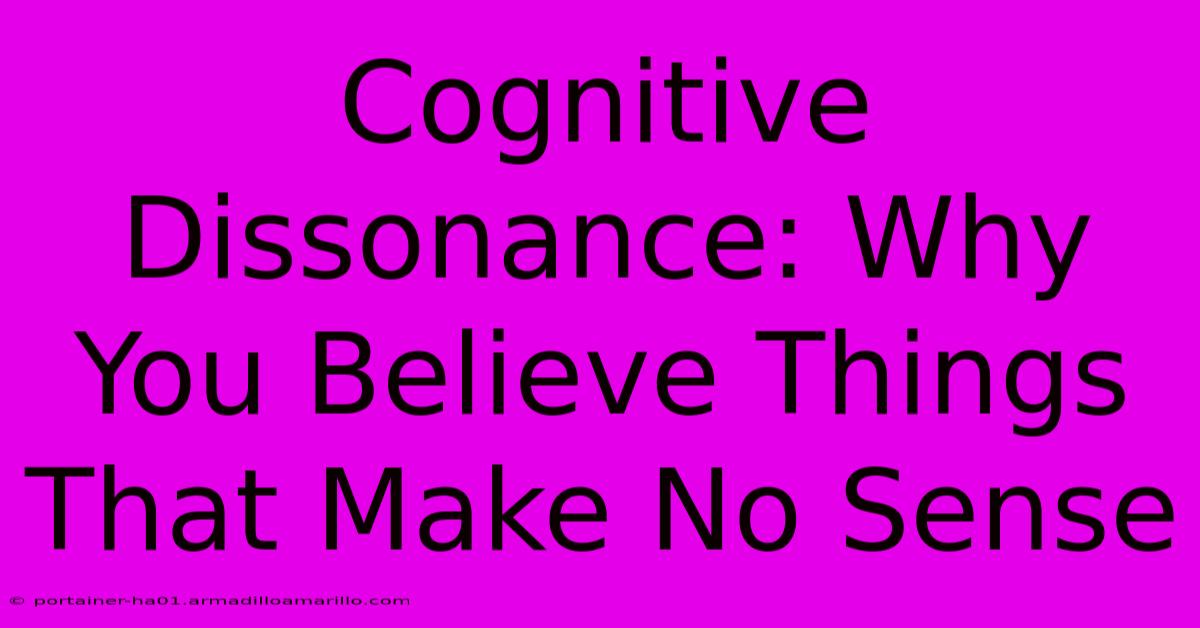Cognitive Dissonance: Why You Believe Things That Make No Sense

Table of Contents
Cognitive Dissonance: Why You Believe Things That Make No Sense
We all like to think of ourselves as rational beings, making logical decisions based on facts and evidence. But the truth is, our minds are often far more complex and contradictory than we realize. This is where cognitive dissonance comes into play. This psychological phenomenon explains why we sometimes hold onto beliefs that directly contradict our experiences or values, leading us to believe things that simply make no sense.
Understanding Cognitive Dissonance
Cognitive dissonance is the mental discomfort experienced by a person who simultaneously holds two or more contradictory beliefs, ideas, or values. This discomfort arises because these conflicting elements create a state of imbalance in the mind. To reduce this unpleasant feeling, our brains employ various strategies, sometimes leading to irrational behaviors and beliefs. The key is that this dissonance is unpleasant, and we are motivated to reduce it.
The Core Conflict: Belief vs. Reality
The heart of cognitive dissonance lies in the clash between what we believe and what we know (or experience). For instance:
-
A smoker who knows smoking causes cancer: The belief ("I want to be healthy") clashes with the behavior ("I smoke"). The dissonance is resolved by downplaying the risk of cancer, justifying the habit, or even denying the link between smoking and cancer altogether.
-
Someone who supports a political candidate who then acts against their stated values: The dissonance is resolved by rationalizing the candidate's actions, focusing on other positive aspects, or simply changing their beliefs about the candidate's values.
-
A person who invests heavily in a company that then performs poorly: The dissonance is often resolved by continuing to believe in the company's potential, downplaying the losses, or even investing more money in a desperate attempt to "average out" the losses.
How We Resolve Cognitive Dissonance
Our minds are remarkably adept at finding ways to alleviate the discomfort of cognitive dissonance. These strategies aren't always rational or healthy, however. Common methods include:
1. Changing our beliefs: The most straightforward approach, but often the most difficult.
This involves acknowledging the contradiction and adjusting our beliefs to align with reality. For a smoker, this could mean quitting. For a voter, it could mean reconsidering their support of a candidate.
2. Changing our behavior: A more direct way to resolve the conflict.
This involves altering actions to match our beliefs. The smoker could quit smoking, and the voter might choose a different candidate.
3. Adding new cognitions: Justifying our beliefs or actions.
This involves adding new information or perspectives to rationalize the inconsistency. The smoker might tell themselves that "everyone dies eventually," downplaying the health risks. The investor might focus on potential future gains.
4. Minimizing the importance of the conflict: Downplaying the significance of the contradiction.
This involves reducing the perceived importance of the conflicting beliefs or behaviors. The smoker might argue that the pleasure of smoking outweighs the health risks. The investor may dismiss the poor performance as a temporary setback.
5. Reducing perceived choice: Believing that they had no real choice in the matter.
This involves minimizing personal responsibility for the situation. For example, a smoker might say they are addicted and have no control.
The Impact of Cognitive Dissonance
The consequences of unresolved cognitive dissonance can be significant. It can lead to:
- Increased stress and anxiety: The constant mental conflict can take a toll on mental well-being.
- Resistance to change: It makes it difficult to accept new information or alter established beliefs.
- Poor decision-making: Rational judgment can be compromised by the need to reduce dissonance.
- Confirmation bias: A tendency to seek out information that confirms existing beliefs and ignore contradictory evidence.
Overcoming Cognitive Dissonance
While cognitive dissonance is a natural human experience, understanding it can help us make more rational decisions and live more authentic lives. By becoming aware of the mechanisms involved, we can:
- Seek out diverse perspectives: Challenge our own beliefs by actively seeking out differing viewpoints.
- Embrace critical thinking: Evaluate information objectively, rather than letting emotions dictate our judgments.
- Accept uncertainty: Recognize that not everything has a simple answer.
- Practice self-compassion: Be kind to ourselves when we make mistakes or hold conflicting beliefs.
By acknowledging the existence of cognitive dissonance and developing strategies to address it, we can move towards a more balanced and rational understanding of ourselves and the world around us. Understanding this inherent human tendency is a crucial step towards clearer thinking and more fulfilling lives.

Thank you for visiting our website wich cover about Cognitive Dissonance: Why You Believe Things That Make No Sense. We hope the information provided has been useful to you. Feel free to contact us if you have any questions or need further assistance. See you next time and dont miss to bookmark.
Featured Posts
-
Nail The Cat Eye Trend Our Top Tips For A Flawless Finish
Feb 07, 2025
-
Unleash Your Creativity Floral Crafts With Babys Breath For Every Occasion
Feb 07, 2025
-
Beyond The Picture The Story Behind Black And White Photo Spot Lighting
Feb 07, 2025
-
Churchills Infernal Edict Unraveling The Devils Whisper In Churchills Wit
Feb 07, 2025
-
Black And White Revelation Aperture Control For Soulful Images
Feb 07, 2025
